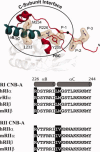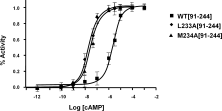Dissecting the cAMP-inducible allosteric switch in protein kinase A RIalpha
- PMID: 20512974
- PMCID: PMC2895245
- DOI: 10.1002/pro.400
Dissecting the cAMP-inducible allosteric switch in protein kinase A RIalpha
Abstract
The regulatory subunits of cAMP-dependent protein kinase (PKA) are the major receptors of cAMP in most eukaryotic cells. As the cyclic nucleotide binding (CNB) domains release cAMP and bind to the catalytic subunit of PKA, they undergo a major conformational change. The change is mediated by the B/C helix in CNB-A, which extends into one long helix that now separates the two CNB domains and docks onto the surface of the catalytic subunit. We explore here the role of three key residues on the B/C helix that dock onto the catalytic subunit, Arg226, Leu233, and Met 234. By replacing each residue with Ala, we show that each contributes significantly to creating the R:C interface. By also deleting the second CNB domain (CNB-B), we show furthermore that CNB-B is a critical part of the cAMP-induced conformational switch that dislodges the B/C helix from the surface of the catalytic subunit. Without CNB-B the K(a) for activation by cAMP increases from 80 to 1000 nM. Replacing any of the key interface residues with Ala reduces the K(a) to 25-40 nM. Leu233 and M234 contribute to a hydrophobic latch that binds the B/C helix onto the large lobe of the C-subunit, while Arg226 is part of an electrostatic switch that couples the B/C helix to the phosphate binding cassette where the cAMP docks.
Figures





Similar articles
-
Structure of a PKA RIα Recurrent Acrodysostosis Mutant Explains Defective cAMP-Dependent Activation.J Mol Biol. 2016 Dec 4;428(24 Pt B):4890-4904. doi: 10.1016/j.jmb.2016.10.033. Epub 2016 Nov 5. J Mol Biol. 2016. PMID: 27825928 Free PMC article.
-
Mutations of PKA cyclic nucleotide-binding domains reveal novel aspects of cyclic nucleotide selectivity.Biochem J. 2017 Jul 6;474(14):2389-2403. doi: 10.1042/BCJ20160969. Biochem J. 2017. PMID: 28583991 Free PMC article.
-
Realizing the allosteric potential of the tetrameric protein kinase A RIα holoenzyme.Structure. 2011 Feb 9;19(2):265-76. doi: 10.1016/j.str.2010.12.005. Structure. 2011. PMID: 21300294 Free PMC article.
-
Signaling through cAMP and cAMP-dependent protein kinase: diverse strategies for drug design.Biochim Biophys Acta. 2008 Jan;1784(1):16-26. doi: 10.1016/j.bbapap.2007.10.002. Epub 2007 Oct 12. Biochim Biophys Acta. 2008. PMID: 17996741 Free PMC article. Review.
-
Dynamics of signaling by PKA.Biochim Biophys Acta. 2005 Dec 30;1754(1-2):25-37. doi: 10.1016/j.bbapap.2005.08.024. Epub 2005 Sep 22. Biochim Biophys Acta. 2005. PMID: 16214430 Review.
Cited by
-
Identifying the hub gene and immune infiltration of osteoarthritis by bioinformatical methods.Clin Rheumatol. 2021 Mar;40(3):1027-1037. doi: 10.1007/s10067-020-05311-0. Epub 2020 Aug 12. Clin Rheumatol. 2021. PMID: 32785809
-
Allostery through the computational microscope: cAMP activation of a canonical signalling domain.Nat Commun. 2015 Jul 6;6:7588. doi: 10.1038/ncomms8588. Nat Commun. 2015. PMID: 26145448 Free PMC article.
-
Ending Restenosis: Inhibition of Vascular Smooth Muscle Cell Proliferation by cAMP.Cells. 2019 Nov 16;8(11):1447. doi: 10.3390/cells8111447. Cells. 2019. PMID: 31744111 Free PMC article. Review.
-
Application of cAMP-dependent catalytic subunit β (PRKACB) Low Expression in Predicting Worse Overall Survival: A Potential Therapeutic Target for Colorectal Carcinoma.J Cancer. 2020 Jun 7;11(16):4841-4850. doi: 10.7150/jca.46156. eCollection 2020. J Cancer. 2020. PMID: 32626531 Free PMC article.
-
Molecular Simulations Reveal an Unresolved Conformation of the Type IA Protein Kinase A Regulatory Subunit and Suggest Its Role in the cAMP Regulatory Mechanism.Biochemistry. 2017 Aug 1;56(30):3885-3888. doi: 10.1021/acs.biochem.7b00461. Epub 2017 Jul 17. Biochemistry. 2017. PMID: 28661131 Free PMC article.
References
-
- Canaves JM, Taylor SS. Classification and phylogenetic analysis of the cAMP-dependent protein kinase regulatory subunit family. J Mol Evol. 2002;54:17–29. - PubMed
Publication types
MeSH terms
Substances
Grants and funding
LinkOut - more resources
Full Text Sources
Research Materials
Miscellaneous

